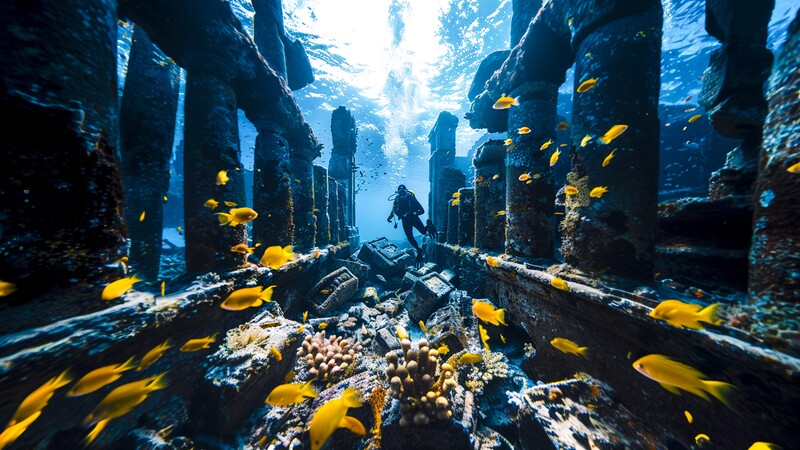Introduction
The vast expanse of the Earth’s oceans remains one of the least explored frontiers on our planet. Despite covering over 70% of the Earth’s surface, a staggering 80% of the underwater world remains unmapped and unseen by human eyes. This mysterious realm holds secrets that could unlock answers to age-old questions, provide resources for future generations, and offer insights into the very origins of life. This article delves deep into the underwater world, shedding light on its wonders, challenges, and the advancements that are propelling our understanding forward.
The Importance of the Underwater World
Biodiversity Hotspots
Oceans are teeming with life. From the tiniest plankton to the colossal blue whale, the marine ecosystem is a tapestry of interconnected species. Coral reefs, often dubbed the “rainforests of the sea,” house a quarter of all marine species despite covering only 1% of the ocean floor. These vibrant ecosystems are not just biodiversity hotspots but also vital for human livelihoods, supporting fisheries and tourism.
Climate Regulation
The oceans play a pivotal role in regulating the Earth’s climate. They absorb about a quarter of the carbon dioxide emitted by human activities, acting as a buffer against climate change. Moreover, ocean currents distribute heat across the globe, influencing weather patterns and ensuring a habitable climate.
Economic Significance
Beyond their ecological importance, oceans are economic powerhouses. They facilitate 90% of global trade through shipping routes, support fisheries that feed billions, and hold untapped resources like minerals and energy reserves. The burgeoning field of blue economy underscores the potential of sustainable ocean-based economic activities.
Challenges in Underwater Exploration
Pressure and Darkness
Venturing into the deep sea is akin to exploring another planet. The immense pressure, which can exceed 1,000 times the atmospheric pressure at sea level, poses significant challenges. At depths beyond 200 meters, sunlight fades, plunging the environment into perpetual darkness. Navigating and operating in such conditions requires advanced technology and robust equipment.
Technological Limitations
While satellite imagery has mapped the surface of Mars and the Moon in high resolution, the same cannot be said for our ocean floors. The opaque nature of water hampers the use of traditional mapping techniques. Relying on sonar and autonomous underwater vehicles (AUVs) offers solutions, but the vastness of the oceans makes comprehensive mapping a herculean task.
Environmental Concerns
Human activities have begun to impact even the remotest parts of the ocean. Pollution, overfishing, and climate change threaten marine habitats. Plastic debris has been found in the Mariana Trench, the deepest part of the ocean, highlighting the pervasive reach of human-induced contamination.
Pioneering Underwater Discoveries
Hydrothermal Vents
In 1977, scientists made a groundbreaking discovery of hydrothermal vents on the ocean floor. These fissures, emitting mineral-rich water heated by the Earth’s mantle, host unique ecosystems devoid of sunlight. The existence of life forms relying on chemosynthesis instead of photosynthesis challenged previous notions about life’s dependencies.
Deep-Sea Species
Continuous exploration has unveiled a plethora of bizarre and fascinating deep-sea creatures. From the anglerfish with its bioluminescent lure to the transparent barreleye fish with its upward-looking eyes, the adaptations of these species offer insights into evolutionary biology.
Submerged Landscapes
Advancements in sonar mapping have revealed submerged landscapes, including ancient riverbeds, mountains, and even potential sites of human habitation from eras when sea levels were lower. These discoveries provide valuable data on Earth’s geological history and climatic shifts.
Technological Advancements Driving Exploration
Autonomous Underwater Vehicles (AUVs)
AUVs have revolutionized underwater exploration. These self-guided robots can traverse the ocean depths, collecting data, capturing images, and mapping terrains without direct human intervention. Their resilience and adaptability make them indispensable tools in modern marine research.
Remote Operated Vehicles (ROVs)
ROVs, tethered to ships, allow scientists to explore deep-sea environments in real-time. Equipped with cameras, manipulators, and sensors, ROVs can conduct intricate tasks, from collecting samples to deploying instruments, bridging the gap between human researchers and the inaccessible underwater world.
Advanced Sonar Systems
Multi-beam and side-scan sonar technologies have enhanced our ability to map the seafloor with unprecedented detail. These systems emit sound waves that bounce off the ocean floor, creating detailed topographical maps essential for navigation, resource exploration, and scientific research.
The Future of Underwater Exploration
Ocean Mapping Initiatives
Global projects like Seabed 2030 aim to map the entire ocean floor by 2030. Collaborative efforts between nations, institutions, and private entities are pooling resources and expertise to achieve this ambitious goal. Comprehensive mapping will aid in navigation, disaster prediction, and environmental conservation.
Deep-Sea Mining
As terrestrial resources dwindle, attention has turned to the ocean’s mineral wealth. Manganese nodules, cobalt-rich crusts, and polymetallic sulfides hold vast reserves of essential metals. However, deep-sea mining poses ecological risks, necessitating stringent regulations and sustainable practices.
Conservation Efforts
Recognizing the threats facing marine ecosystems, international bodies are championing conservation initiatives. The establishment of marine protected areas (MPAs), stricter fishing regulations, and pollution control measures are steps towards preserving the ocean’s health and biodiversity.
Conclusion
The underwater realm remains a frontier brimming with mysteries, challenges, and opportunities. As technology propels us deeper into the abyss, our understanding of this vast ecosystem grows, revealing the intricate tapestry of life and processes that sustain our planet. Balancing exploration with conservation is paramount to ensure that the wonders of the ocean endure for generations to come. The journey into the depths is not just a scientific endeavor but a testament to human curiosity, resilience, and responsibility.
